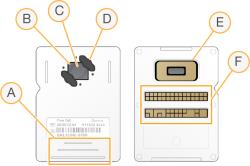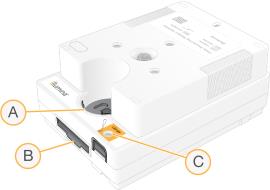Kit Contents and Storage
iSeq 100 i1 Reagent kits provides the cartridge and flow cell for sequencing.
|
Bundle |
Component |
Quantity |
Storage Temperature |
|---|---|---|---|
|
Single |
Cartridge |
1 |
-25°C to -15°C |
|
Flow cell |
1 |
2°C to 8°C* |
|
|
Four-pack |
Cartridge |
4 |
-25°C to -15°C |
|
Flow cell |
4 |
2°C to 8°C* |
|
|
Eight-pack |
Cartridge |
8 |
-25°C to -15°C |
|
Flow cell |
8 |
2°C to 8°C* |
*Shipped at room temperature.
When you receive iSeq 100 i1 Reagent kits, promptly store components at the appropriate conditions to ensure proper performance:
| • | Store at the indicated temperatures. |
| • | Do not open the white foil packaging until instructed to do so. The cartridge is thawed in the bag. |
| • | Position the cartridge so that the package label faces up. |
| • | Store the cartridge for at least one day before thawing in a water bath. |
The iSeq 100 i1 Flow Cell is a patterned, single-lane flow cell built over a complementary metal oxide semiconductor (CMOS) optical sensor. A plastic cartridge encases the glass-based flow cell. Raised grip points on the plastic ensure safe handling.

- Grip points
- CMOS sensor (top)
- Imaging area
- Gasket (one of two)
- CMOS sensor (bottom)
- Electrical interface
Millions of nanowells cover the surface of the flow cell. Clusters are generated in the nanowells, from which the sequencing reaction is then performed. The ordered arrangement of the nanowells increases output reads and data. During sequencing, the CMOS sensor captures images for analysis.
For tracking and ensuring compatibility, the flow cell uses an electrical interface: electrically erasable programmable read-only memory (EEPROM).
The C iSeq 100 Cartridge is prefilled with clustering, sequencing, paired-end, and indexing reagents. A foil‑sealed reservoir is reserved for libraries and custom primers, and a slot on the front is reserved for the flow cell. Illuminator light reaches the flow cell through an access window on top of the cartridge.

- Access window
- Flow cell slot
- Library reservoir
The cartridge holds all consumables for a run: reagents, library, and flow cell. The library and flow cell are loaded into the thawed cartridge, which is then loaded onto the instrument. Radio‑frequency identification (RFID) ensures compatibility and tracking.
After the run begins, reagents and library are automatically transferred from the cartridge to the flow cell. An underside reservoir collects used reagents. The cartridge also contains pumps, valves, and all other fluidics for the system. Because the cartridge is discarded after a run, instrument washes are not necessary.
